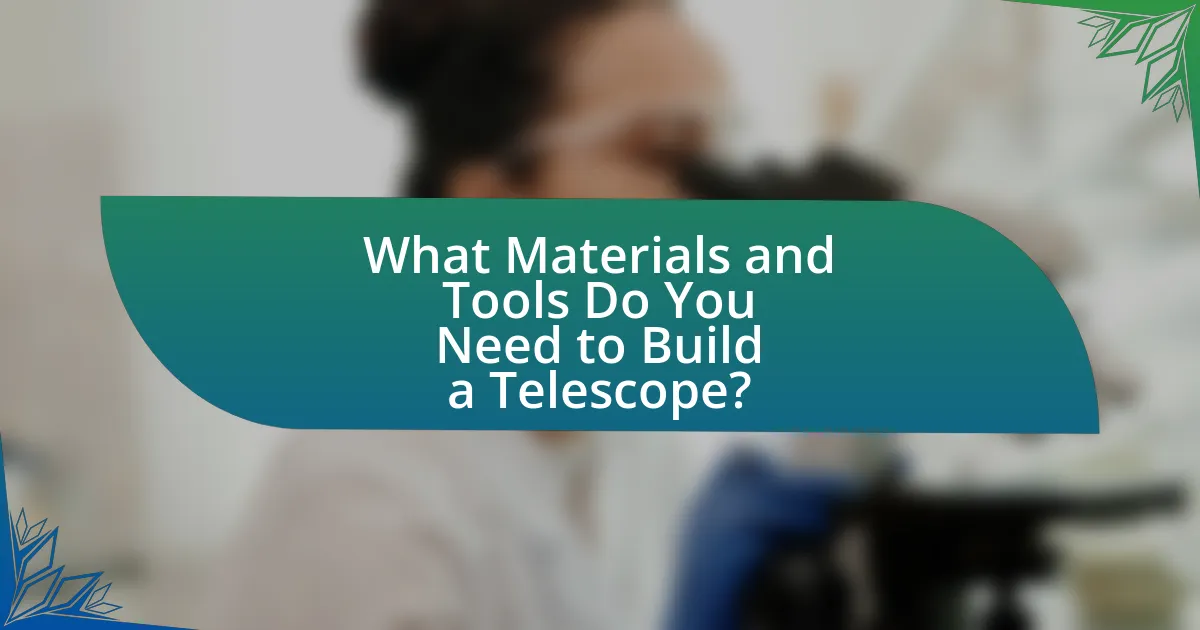The article provides a comprehensive guide on how to build your own telescope, aimed at beginners interested in astronomy. It covers the fundamental concepts of telescope functionality, including the key components such as lenses, mirrors, and mounts, and explains how different designs affect performance. The guide emphasizes the advantages of building a telescope, including customization, cost savings, and enhanced learning opportunities. Additionally, it outlines the necessary materials and tools, step-by-step assembly instructions, alignment techniques, and troubleshooting tips to ensure successful construction and optimal performance.

What is a Telescope and Why Build Your Own?
A telescope is an optical instrument designed to observe distant objects by collecting and magnifying light. Building your own telescope allows for customization, a deeper understanding of optics, and the satisfaction of creating a functional device tailored to your specific observational needs. Additionally, constructing a telescope can be more cost-effective than purchasing a commercial model, enabling enthusiasts to explore astronomy without significant financial investment.
How does a telescope function?
A telescope functions by collecting and magnifying light from distant objects to make them visible. It achieves this through a combination of lenses or mirrors that focus light, allowing the observer to see details that are not visible to the naked eye. For instance, refracting telescopes use lenses to bend light, while reflecting telescopes utilize mirrors to gather and reflect light to a focal point. The design and arrangement of these optical components determine the telescope’s ability to resolve fine details and gather light, which is crucial for observing celestial bodies.
What are the key components of a telescope?
The key components of a telescope are the optical elements, which include the objective lens or mirror, the eyepiece, and the mount. The objective lens or mirror gathers light and focuses it to create an image, while the eyepiece magnifies that image for viewing. The mount provides stability and allows for movement to track celestial objects. These components work together to enhance the observation of distant astronomical objects, making telescopes essential tools in astronomy.
How do different designs affect telescope performance?
Different telescope designs significantly impact performance by influencing factors such as light gathering ability, resolution, and ease of use. For instance, refractor telescopes utilize lenses to focus light, providing high contrast and sharp images, making them ideal for planetary observation. In contrast, reflector telescopes use mirrors, allowing for larger apertures that gather more light, which enhances the visibility of faint objects in deep-sky observations. Additionally, compound telescopes combine features of both designs, offering versatility and compactness, which can improve portability without sacrificing performance. The choice of design directly correlates with the intended use, as each type has unique advantages and limitations that affect overall observational capabilities.
What are the advantages of building your own telescope?
Building your own telescope offers several advantages, including customization, cost-effectiveness, and enhanced learning opportunities. Customization allows individuals to select specific components and features that suit their personal observing preferences, such as aperture size and mount type. Cost-effectiveness is evident as constructing a telescope can be significantly cheaper than purchasing a pre-made model, especially for larger apertures. Enhanced learning opportunities arise from the hands-on experience of assembling the telescope, which deepens understanding of optics, mechanics, and astronomy. This practical knowledge can lead to greater appreciation and enjoyment of stargazing.
How does customization enhance the observing experience?
Customization enhances the observing experience by allowing users to tailor their telescopes to specific preferences and needs. This personalization leads to improved comfort and efficiency during observation sessions, as users can adjust features such as eyepiece selection, mount type, and optical configurations to suit their individual viewing styles. Research indicates that customized equipment can significantly increase user satisfaction and engagement, as it aligns with personal interests and enhances the overall enjoyment of stargazing.
What cost savings can be achieved by building your own telescope?
Building your own telescope can lead to significant cost savings, often ranging from 30% to 70% compared to purchasing a commercially available telescope. For instance, a high-quality commercial telescope can cost upwards of $1,000, while the materials needed to construct a similar telescope can be sourced for as little as $300. Additionally, by selecting components based on personal preferences and budget constraints, individuals can further reduce expenses. This approach not only saves money but also allows for customization, enhancing the overall value of the telescope.

What Materials and Tools Do You Need to Build a Telescope?
To build a telescope, you need specific materials and tools including a telescope tube, lenses or mirrors, a mount, and a finder scope. The telescope tube serves as the main body, while lenses or mirrors are essential for gathering and focusing light. A sturdy mount is necessary to support the telescope and allow for smooth movement, and a finder scope helps locate celestial objects. Additionally, tools such as a drill, screws, and a screwdriver are required for assembly. These components are fundamental for constructing a functional telescope, as they directly influence its performance and usability.
What types of materials are suitable for telescope construction?
Suitable materials for telescope construction include aluminum, steel, wood, and various plastics. Aluminum is favored for its lightweight and corrosion-resistant properties, making it ideal for telescope tubes and mounts. Steel offers strength and stability, often used in the construction of sturdy mounts. Wood, particularly plywood, is used for its ease of shaping and aesthetic appeal, commonly found in telescope bases. Plastics, such as acrylic, are utilized for lens and mirror housings due to their lightweight and moldable characteristics. These materials are chosen based on their mechanical properties, weight, and durability, ensuring effective performance in astronomical observations.
What are the best types of lenses and mirrors for beginners?
The best types of lenses for beginners are achromatic doublet lenses, while the best mirrors are parabolic mirrors. Achromatic doublet lenses minimize chromatic aberration, providing clearer images, which is essential for beginners who are learning to observe celestial objects. Parabolic mirrors focus light to a single point, making them ideal for reflecting telescopes, as they offer better image quality and are easier to construct for novice telescope builders. These choices are widely recommended in astronomy resources, such as “The Backyard Astronomer’s Guide” by Terence Dickinson and Alan Dyer, which emphasizes the importance of quality optics for effective stargazing.
How do you choose the right mounting materials?
To choose the right mounting materials for building a telescope, assess the weight and size of the telescope components to ensure compatibility with the mounting system. For instance, heavier telescopes require sturdier mounts, such as equatorial or altazimuth mounts made from durable materials like aluminum or steel, which provide stability and reduce vibrations. Additionally, consider the intended use; for astrophotography, a mount with precise tracking capabilities is essential. Research indicates that a stable mount can significantly enhance viewing experiences and image quality, as evidenced by studies showing that vibrations can distort images, making a solid mount crucial for optimal performance.
What essential tools are required for building a telescope?
To build a telescope, essential tools include a sturdy base, optical lenses, a tube for housing the lenses, a mount for stability, and a finder scope for alignment. The sturdy base provides support, while optical lenses are crucial for magnification and clarity. The tube houses the lenses and maintains alignment, and the mount ensures stability during observation. A finder scope aids in locating celestial objects. These components are fundamental for constructing a functional telescope, as they directly influence the instrument’s performance and usability.
Which tools are necessary for assembly and adjustments?
The necessary tools for assembly and adjustments of a telescope include a screwdriver set, pliers, a wrench set, and a level. These tools facilitate the precise assembly of components and ensure proper alignment during adjustments. For instance, a screwdriver set is essential for securing screws in various parts of the telescope, while pliers and wrenches are used to tighten nuts and bolts effectively. A level is crucial for ensuring that the telescope is properly aligned for accurate observations.
How can you ensure precision in your construction process?
To ensure precision in your construction process, utilize high-quality tools and materials, and adhere to detailed measurements and specifications. Employing tools such as laser levels and digital calipers can significantly enhance accuracy, as they provide precise readings that minimize human error. Additionally, following a well-structured plan or blueprint ensures that each component is constructed to exact dimensions, which is crucial in telescope assembly where even minor discrepancies can affect performance. Studies in construction accuracy indicate that projects using advanced measuring technologies can reduce errors by up to 30%, highlighting the importance of precision in achieving successful outcomes.

How Do You Assemble Your Telescope Step by Step?
To assemble your telescope step by step, first, lay out all components including the optical tube, mount, and tripod. Begin by attaching the optical tube to the mount, ensuring it is securely fastened according to the manufacturer’s instructions. Next, connect the mount to the tripod, making sure it is stable and level. After that, insert the finderscope onto the optical tube, aligning it properly for accurate targeting. Finally, place the eyepiece into the optical tube and adjust the telescope to your desired viewing position. This assembly process is essential for optimal performance and stability during use.
What is the first step in building your telescope?
The first step in building your telescope is to select the type of telescope you want to construct, such as a refractor or reflector. This decision is crucial because it determines the materials and design specifications needed for the project. For instance, refractors use lenses to gather light, while reflectors utilize mirrors, each requiring different construction techniques and components. Understanding these differences ensures that you gather the appropriate materials and tools for your specific telescope type, laying a solid foundation for the building process.
How do you prepare your workspace for assembly?
To prepare your workspace for assembly, first ensure that the area is clean and organized, providing ample space for all components. A clutter-free environment minimizes distractions and reduces the risk of losing small parts. Additionally, gather all necessary tools and materials, such as screws, a screwdriver, and the telescope components, to streamline the assembly process. Proper lighting is also essential, as it allows for better visibility of intricate parts and instructions. Following these steps creates an efficient workspace conducive to successful assembly.
What safety precautions should you take during assembly?
During assembly, you should wear safety goggles to protect your eyes from debris and sharp objects. Additionally, using gloves can prevent cuts and abrasions while handling tools and materials. Ensuring a clean workspace minimizes the risk of accidents, as clutter can lead to tripping hazards. It is also crucial to follow the manufacturer’s instructions carefully to avoid improper assembly that could result in equipment failure or injury. Lastly, keeping tools organized and using them as intended reduces the likelihood of accidents. These precautions are essential for maintaining safety during the assembly process.
How do you align and calibrate your telescope?
To align and calibrate your telescope, first ensure it is set up on a stable surface and level. Next, use a sighting tool or a finderscope to align the telescope with a bright celestial object, such as a star or planet. Adjust the finderscope until the object is centered in its view, then look through the main telescope to confirm the object is also centered there. For calibration, check the telescope’s tracking by observing the object over time; if it drifts out of view, adjust the mount’s settings according to the manufacturer’s instructions. This process ensures accurate tracking and alignment, which is essential for effective stargazing.
What techniques can you use for accurate alignment?
For accurate alignment of a telescope, techniques such as using a polar alignment scope, employing a laser collimator, and performing star alignment are essential. A polar alignment scope helps align the telescope with the Earth’s axis, ensuring accurate tracking of celestial objects. A laser collimator assists in aligning the optical elements of the telescope, which is crucial for clear images. Star alignment involves using known stars to calibrate the telescope’s positioning system, enhancing its ability to locate and track objects in the night sky. These methods are widely recognized in astronomy for improving observational accuracy.
How do you test the telescope’s performance after assembly?
To test the telescope’s performance after assembly, conduct a star test by observing a bright star at high magnification. This method allows you to evaluate the telescope’s optics by examining the shape of the star’s image; a well-collimated telescope will show a symmetrical pattern of diffraction rings around the star. Additionally, check for focus sharpness and clarity across the field of view, ensuring that images remain clear and detailed. This testing process is essential for confirming that the telescope’s components are properly aligned and functioning as intended.
What are common challenges faced when building a telescope?
Common challenges faced when building a telescope include achieving precise alignment, selecting appropriate materials, and ensuring optical quality. Precise alignment is crucial because misalignment can lead to poor image quality and difficulty in locating celestial objects. Selecting appropriate materials is challenging due to the need for lightweight yet sturdy components that can withstand environmental conditions. Ensuring optical quality involves complex calculations and adjustments to minimize aberrations, which can significantly affect the telescope’s performance. These challenges require careful planning and technical knowledge to overcome effectively.
How can you troubleshoot alignment issues?
To troubleshoot alignment issues in a telescope, first ensure that the mount is level and stable. A level mount is crucial for accurate alignment, as it prevents misalignment caused by uneven surfaces. Next, check that the finderscope is properly aligned with the main telescope; this can be done by centering an object in the main scope and adjusting the finderscope until the object is also centered there. Additionally, verify that the optical components, such as the primary and secondary mirrors, are correctly positioned and collimated, as misalignment of these components can lead to poor image quality. Regularly reviewing these steps can help maintain proper alignment and improve overall performance.
What solutions exist for common construction mistakes?
Solutions for common construction mistakes in telescope building include thorough planning, using precise measurements, and employing quality materials. For instance, ensuring accurate alignment of optical components can prevent issues with image quality. Additionally, utilizing templates or jigs can help maintain consistency in cuts and assembly, reducing errors. Regularly consulting construction guides or expert resources can also provide valuable insights and troubleshooting tips, enhancing the overall building process.
What tips can enhance your telescope-building experience?
To enhance your telescope-building experience, start by thoroughly researching telescope designs and components to understand their functions and compatibility. This foundational knowledge allows for informed decisions when selecting materials and tools, ultimately leading to a more successful build. Additionally, joining online forums or local astronomy clubs can provide valuable insights and support from experienced builders, which can help troubleshoot issues and share best practices. Engaging with a community fosters learning and can inspire creativity in your design choices. Lastly, maintaining a detailed log of your building process can help identify what works well and what doesn’t, facilitating improvements in future projects.
How can you find resources and communities for support?
To find resources and communities for support in building your own telescope, utilize online platforms such as astronomy forums, social media groups, and dedicated websites like Cloudy Nights and Reddit’s r/telescopes. These platforms provide access to experienced hobbyists and professionals who share knowledge, tips, and troubleshooting advice. Additionally, local astronomy clubs often host events and workshops, offering hands-on support and networking opportunities. Engaging with these communities can enhance your learning experience and provide valuable insights into telescope building.
What best practices should you follow for successful telescope use?
To ensure successful telescope use, follow these best practices: first, set up your telescope in a stable, level location away from light pollution to enhance visibility of celestial objects. Proper alignment of the telescope with the celestial coordinates is crucial for accurate tracking. Additionally, allow the telescope to acclimate to the outdoor temperature to reduce image distortion caused by thermal currents. Using a star chart or astronomy app can help identify objects in the night sky, improving your observational experience. Regularly check and clean the optics to maintain clarity and performance. These practices are supported by the guidelines from the American Astronomical Society, which emphasize the importance of setup and maintenance for optimal viewing.




